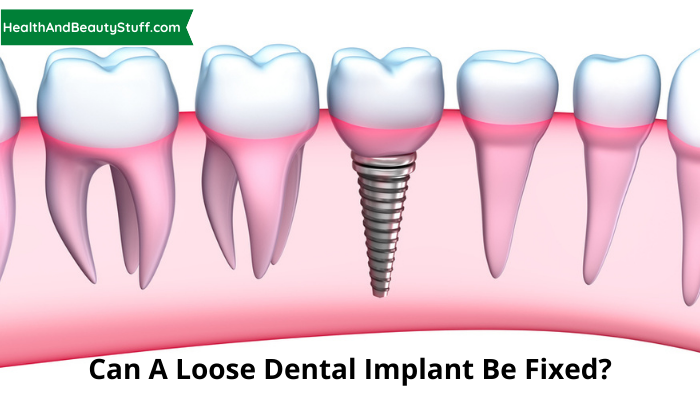Losing a tooth is an unfortunate experience that could lead to various problems, including difficulties in speaking and eating. Dental implants are an effective way to replace missing teeth as they are designed to fuse with the jawbone, providing a strong and stable foundation. However, in some cases, dental implants can become loose. This can be due to several factors, including infection, trauma, or a weakened jawbone. If you’re experiencing a loose dental implant, it’s important to seek professional help promptly to prevent further damage and improve your oral health. Here’s a comprehensive guide to understanding the causes, symptoms, and treatment options for loose dental implants.

Image: healthandbeautystuff.com
Causes of Loose Dental Implants
Several factors can contribute to the loosening of a dental implant. These include:
- Infection: Bacterial infection around the implant can weaken the bond between the implant and the jawbone, causing it to become loose. Peri-implant disease, a condition that affects the tissues surrounding the implant, can develop if not treated properly, leading to further complications.
- Trauma: A traumatic event, such as a blow to the face, can cause a dental implant to loosen or even break. This is relatively common in contact sports or other high-impact activities.
- Weakened jawbone: The jawbone may lose density and strength over time due to various factors, including osteoporosis, periodontal disease, and smoking. This can weaken the support for the implant, causing it to become loose.
- Poor maintenance: Failing to maintain proper oral hygiene can increase the risk of implant failure. Inadequate brushing and flossing can lead to the accumulation of bacteria and plaque, which can cause infections and weaken the surrounding bone structure.
- Inadequate time for healing: Dental implants require a specific amount of time to properly integrate with the jawbone through a process called osseointegration. If the implant is loaded with chewing forces prematurely, it can prevent proper healing and lead to loosening over time.
Symptoms of Loose Dental Implants
Recognizing the symptoms of a loose dental implant is essential for seeking timely intervention. The common symptoms include:
- Mobility: A loose dental implant may feel wobbly or move slightly when touched. This is a clear indication that the implant is not fully anchored in the jawbone and requires attention.
- Sensitivity: Loose implants can become more sensitive to hot or cold temperatures due to exposed areas between the implant and the gum tissue. This can cause discomfort and pain, especially during eating or drinking.
- Pain: Loose implants often cause discomfort and even pain in the affected area. This pain can range from mild to severe depending on the extent of loosening and any underlying inflammation.
- Gum swelling and redness: The gum tissue surrounding a loose implant may appear swollen and red, indicating infection or inflammation. This inflammation can lead to bleeding or pus discharge, further compromising the implant’s stability.
- Chewing difficulties: Chewing force can put stress on a loose implant, making it difficult to eat comfortably. This can affect one’s ability to eat certain foods and can impact overall nutrition.
Treatment Options for Loose Dental Implants
The treatment for a loose dental implant depends on the severity of the condition and the underlying cause. The most common treatment options include:
- Antibiotic therapy: If infection is the primary cause of the loose implant, antibiotic therapy may be necessary to eliminate the bacteria and control the infection. This involves the use of oral or intravenous antibiotics to target the specific bacteria responsible for the infection.
- Tightening the implant: In some cases, the implant can be tightened to improve its stability. This involves adjusting the abutment or screw that connects the implant to the artificial tooth. Tightening the implant can help restore a secure fit and prevent further loosening.
- Bone grafting: If the jawbone has deteriorated, bone grafting may be necessary to add support to the implant. This involves taking bone from another part of the body or using synthetic bone material to augment the jawbone and provide a stronger foundation for the implant.
- Implant removal: In severe cases, the implant may need to be removed if it can’t be successfully stabilized. This is typically done if the implant has become infected or the jawbone damage is extensive, making it impossible to restore the implant’s stability.
- Re-implantation: In some cases, it may be possible to remove the loose implant, clean it, and re-implant it into the jawbone. This involves a surgical procedure to remove the implant, treat the underlying cause of the loosening, and re-insert the implant into a healthy jawbone site.

Image: www.youtube.com
How To Fix Loose Dental Implant
Conclusion
A loose dental implant can be a concerning issue, but it’s important to remember that early detection and prompt treatment can help prevent further complications and improve your oral health. If you notice any symptoms of a loose implant, such as mobility, sensitivity, or pain, it’s crucial to schedule an appointment with your dentist for evaluation and appropriate treatment. With proper care and timely intervention, you can restore the functionality and longevity of your dental implant, preserving your smile and overall well-being.